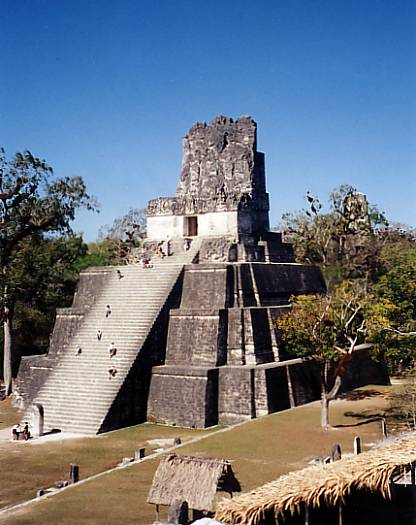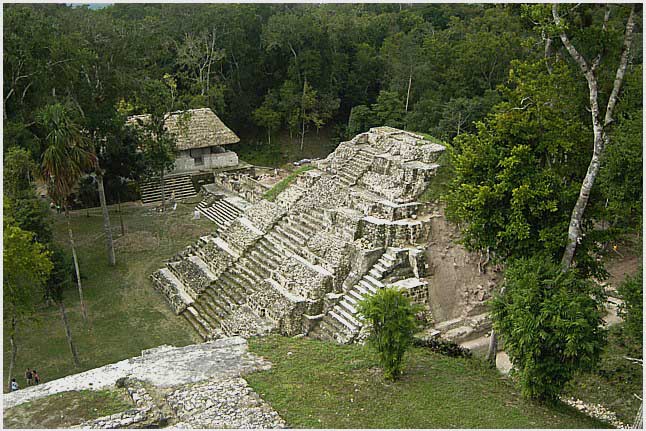PeopleAn estimated 13,000,000 people live in Guatemala and approximately half of them are descendents of the Mayans. Most Mestizo, or of mixed Amerindian and Spanish ancestry. Pure Amerindian populations include the K'iche, Kaqchikel, Mam, and Q'eqchi.
Other cultures found in the country are the Garifuna, mixed descendants of Africans and indigenous people from St. Vincent's, as well as Arabs of Lebanese and Syrian descent, Asians of Chinese ancestry, a growing Korean community, and an established group of Germans who are responsible for introducing the Christmas tree into Guatemalan culture. |
Guatemala has a long, rich history that begins with the great and mystical Mayan Civilization. Evidence of that advanced culture can be found all throughout the region, making a visit to the country a necessity for both history aficionados and Mayan scholars alike. Guatemala is a Central American country that shares a border with Belize, El Salvador, Honduras, the Caribbean and Mexico. It is an astoundingly beautiful country, full of mountains and volcanic peaks, lush tropical forests, and exotic flora and fauna to keep a nature lover busy for days. Though the civilization is gone, the Mayan culture remains vibrantly alive in its modern day descendents. The glory of days past can be seen in the beautiful baskets, pottery, wood carvings and other assorted handicrafts created by men and women of the area using the same techniques their ancestors used thousands of years ago. |
Geography
Except for the coastal area in the south and lowlands of the north, Guatemala is a very mountainous country. Two mountain ranges divide the country into three parts: the highlands, the Pacific Coast, and the Peten region. All three areas vary in climate, with the lowlands enjoying typical tropical heat and humidity, and the highlands enduring much cooler and drier weather. The best time to visit the country is between the months of December and April when the rainy season has passed.
Guatemala is situated in somewhat of a disaster prone zone, located between the Caribbean Sea and the Pacific, making it a prime target for hurricanes. In addition, its proximity to the Caribbean and North American tectonic plates has subjected it to several major earthquakes. And if that isn't exciting enough, Guatemala has four active volcanoes: Pacaya, Santiaguito, Fuego and Tacana
Guatemala is situated in somewhat of a disaster prone zone, located between the Caribbean Sea and the Pacific, making it a prime target for hurricanes. In addition, its proximity to the Caribbean and North American tectonic plates has subjected it to several major earthquakes. And if that isn't exciting enough, Guatemala has four active volcanoes: Pacaya, Santiaguito, Fuego and Tacana
HistoryGuatemala is an old country, inhabited for many thousands of years. The first settlers were were likely a hunter-gatherer society that slowly evolved into the powerful Mayan Civilization. When the dynasty collapsed suddenly, in 900 AD, the people either abandoned the lands or died because of a drought induced famine.
Fast forward several thousand years to 1519, when the Spanish began exploring Guatemala and infecting the indigenous people with new diseases that decimated the native population. Captains Gonzalo and Pedro de Alvarado were granted permission to conquer the lands, and they enlisted the help of the Kaqchikel nation to fight against other tribes. Eventually, though, the brothers betrayed them and brought the entire region under Spanish control. After about three hundred years of relatively uneventful Spanish rule, on September 15, 1821 Guatemala officially proclaimed its independence from Spain and was incorporated into the Mexican Empire that only lasted for two years. |
Famous Attraction
The Mayan ruins, by far, should be first on your list of things to see in Guatemala. As part of that amazing civilization, remnants of the ancient culture can be seen throughout the country. Although, Tikal is the site with the majority of these historical structures, smaller monuments can be found all over Guatemala.
For an experience that can only be described as a little otherworldly, visit Chichicastenango, a town that has remained steadfast in its adherence to the ancient religious beliefs and culture and often seems out of step with its Guatemalan Christian brethren. It is also well known for its Thursday and Sunday market days where shopaholics can snatch up all sorts of great locally made items.
The country's Pacific coast offers a unique beach experience with its black sand, a direct result of living in a country with four active volcanoes. You can visit Monterrico beach to take pictures of its unusual sand color, or you can grab a beach blanket, stretch out and enjoy the relaxing peace and quiet for the whole afternoon.
For an experience that can only be described as a little otherworldly, visit Chichicastenango, a town that has remained steadfast in its adherence to the ancient religious beliefs and culture and often seems out of step with its Guatemalan Christian brethren. It is also well known for its Thursday and Sunday market days where shopaholics can snatch up all sorts of great locally made items.
The country's Pacific coast offers a unique beach experience with its black sand, a direct result of living in a country with four active volcanoes. You can visit Monterrico beach to take pictures of its unusual sand color, or you can grab a beach blanket, stretch out and enjoy the relaxing peace and quiet for the whole afternoon.
NightlifeJust because it is a country with a long and rich history, doesn't mean the people of Guatemala don't know how to have fun. The country is full of bars and nightclubs where you can go have a drink and give the dance floor a try. Nyx is the place to go if you want to rub shoulders with international celebrities. If hanging out with the Glitterati is not your thing, then Kahlua is a great place for good drinks and good conversation with the locals. Whatever kind of entertainment you want, you're sure to find a nightclub to match your style.
|
Culture
Spanish is the official language of Guatemala but it is only one of several spoken by its inhabitants. There are twenty-one different Mayan languages spoken by the indigenous people, including Quiche, Cakchiquel, Kekchi, and Mam plus two non-Mayan language - Xinca and Garifuna. Guatemalans often speak not only Spanish but several other Mayan languages in addition to their own native tongue.
Catholicism is the dominant religion of the region but about 40% are Protestant. Although only 1% continues to practice the traditional Mayan religions of old, this number has been increasing in recent years due to established cultural protections.
Other religions that represented in Guatemala are Judaism, Islam, and Buddhism.
Catholicism is the dominant religion of the region but about 40% are Protestant. Although only 1% continues to practice the traditional Mayan religions of old, this number has been increasing in recent years due to established cultural protections.
Other religions that represented in Guatemala are Judaism, Islam, and Buddhism.
CuisineThe food in Guatemala is different in each region of the country due to the diversity of cultures in the nation. Many traditional Guatemalan meals are based around the staples of corn, chilis, and beans. It is important to note that although a dish may have the same name as a dish in other countries, the food may be prepared in a completely different way. For example, enchiladas in Guatemala are nothing like those made in Mexico.
A favorite is a sweet candy made in Antigua. The candy consists of fruits, seeds, nuts, honey, and condensed milk, and is a hit with both tourists and locals alike. Another country favorite are tamales made from banana leaves filled with steam-cooked corn meal and an assortment of vegetables and meats. |
Qunar







